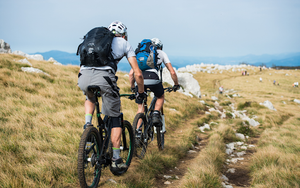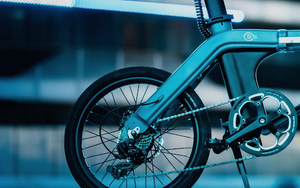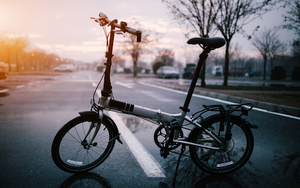How Fast Do Electric Bikes Go Without Pedalling?
Aug 14, 2024
Electric bikes, or e-bikes, have gained significant popularity in recent years. With their ability to provide a boost of power, they offer a convenient and eco-friendly alternative to traditional bicycles. One of the key advantages of e-bikes is their ability to reach higher speeds without the need for extensive pedalling. In this article, we will delve into the factors that affect the speed of electric bikes and discuss safety considerations for high-speed e-biking.
Understanding Electric Bike Speed
When it comes to the speed of an electric bike, there are several factors to consider. The most influential factors are the power of the motor and the life of the battery.
Electric bikes, also known as e-bikes, have gained popularity for their ability to provide an eco-friendly and efficient mode of transportation. One of the key aspects that riders often consider is the speed at which an e-bike can travel. Understanding the relationship between motor power, battery life, and speed can help riders make informed decisions when choosing an electric bike that suits their needs.
The Role of Motor Power in E-Bike Speed
The power of the motor plays a crucial role in determining how fast an electric bike can go. The higher the power rating of the motor, the faster the e-bike can travel. Generally, e-bike motors can have power ratings ranging from 250 watts to 1000 watts or more. Higher-powered motors provide greater speed, allowing riders to reach speeds of up to 28 mph or more, however the average speed limit on e-bikes is 15-16 mph, such as with the Ado A20 XE. However, it's important to note that the maximum speed may be limited by legal requirements or manufacturer-set speed limits.
Additionally, the type of motor can also impact the speed of an electric bike. There are different types of motors used in e-bikes, such as hub motors and mid-drive motors. Hub motors are located in the wheel hub and provide a boost to the wheel's rotation, while mid-drive motors are positioned near the bike's pedals, offering a more natural riding experience. The placement and type of motor can influence the overall performance and speed capabilities of the e-bike.

Impact of Battery Life on Speed
The battery life of an e-bike directly affects its speed. As the battery depletes, the power output of the motor decreases, resulting in a decrease in speed. Therefore, a fully charged battery will typically enable the e-bike to achieve its maximum speed. It's important to consider the range of the battery, as a larger capacity battery will provide a longer distance at the maximum speed compared to a smaller capacity battery.
Moreover, advancements in battery technology have led to the development of more efficient and long-lasting batteries for e-bikes.
Lithium-ion batteries are commonly used in electric bikes due to their high energy density and lightweight properties. These batteries can be recharged multiple times and have a longer lifespan compared to traditional lead-acid batteries. Riders can now enjoy extended rides at higher speeds with the latest battery innovations available in the market.
Factors Affecting the Speed of Electric Bikes
In addition to motor power and battery life, there are other factors that can influence the speed of an electric bike.
Weight and Its Influence on E-Bike Speed
The weight of the e-bike and the rider can affect the speed at which the e-bike can travel.
Heavier e-bikes require more power to reach and maintain higher speeds. Additionally, the weight of the rider can impact speed as well. A heavier rider may experience slower acceleration and reduced top speed compared to a lighter rider. Therefore, it's important to consider the weight of both the e-bike itself and the rider when assessing the potential speed of an electric bike.
Terrain and E-Bike Speed
The terrain on which an e-bike is ridden can significantly impact its speed. Uphill segments require more power from the motor to overcome gravity, resulting in slower speeds. On the other hand, riding on flat or downhill terrain allows the e-bike to reach its maximum speed more easily. When considering the speed of an electric bike, it's essential to take into account the type of terrain it will be predominantly used on.

Speed Limits for Electric Bikes
While electric bikes offer the advantage of higher speeds, there are legal speed limits that riders must adhere to.
Legal Speed Limits for E-Bikes
The legal speed limits for e-bikes vary between countries and regions. In some areas, e-bikes are subject to the same speed limits as traditional bicycles. In the UK, general traffic speed limits have to be adhered to. However, it's crucial to check the specific regulations in your locality, as they can vary.
Manufacturer-Set Speed Limits
In addition to legal speed limits, some e-bike manufacturers set maximum speed limits on their bikes for safety reasons. This serves to prevent users from pushing the e-bike beyond its design capabilities and potentially compromising their safety. Therefore, it's important to be aware of any manufacturer-set speed limits and ensure compliance to maintain a safe riding experience.
Enhancing the Speed of Your Electric Bike
If you're looking to maximise the speed of your electric bike, there are a few tips and upgrades that you can consider.
Maintenance Tips for Optimal Speed
Regular maintenance is essential for keeping your electric bike in optimal condition and ensuring that it performs at its best. This includes checking the tire pressure, lubricating the chain, and inspecting the brakes. By keeping your e-bike well-maintained, you can help ensure that it reaches its maximum speed efficiently.
Upgrades for a Faster Electric Bike
If you're seeking even greater speed, there are various upgrades available for electric bikes. Upgrading to a higher-powered motor can provide a significant boost in speed. Additionally, upgrading to a higher-capacity battery can extend the range at maximum speed. However, it's important to note that modifying an e-bike may have legal implications, so it's crucial to check the regulations in your area before making any modifications.

Safety Considerations for High-Speed E-Biking
Riding an electric bike at higher speeds presents unique safety considerations that riders should be aware of, especially with their rise in popularity. Research shows that 14% of cyclists intend to buy an e-bike in the next year.
Protective Gear for Electric Bike Riders
When riding at higher speeds, it's recommended to wear proper protective gear. This includes a helmet to protect the head in case of an accident, as well as knee and elbow pads for added protection. Wearing sturdy shoes can also help ensure stability and control while riding at higher speeds.
Safe Riding Practices at High Speeds
At higher speeds, it's important to practise safe riding habits to minimise the risk of accidents. This includes maintaining a safe following distance from other vehicles, obeying traffic laws, and being aware of your surroundings. Additionally, it's crucial to ride within your skill level and exercise caution when taking turns or manoeuvring through traffic.
So, How Fast Can Electric Bikes Go?
In conclusion, electric bikes can reach impressive speeds without extensive pedalling. The power of the motor and the battery life are the main factors that determine the maximum speed of an electric bike. Other factors such as weight and terrain can also influence the speed at which an e-bike can travel.
While enjoying the speed capabilities of an electric bike, it's important to adhere to legal speed limits and consider any manufacturer-set limits for a safe and enjoyable riding experience.
Click here to speak to the e-Dash team to see which electric bike is the best option for you.






